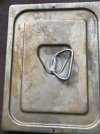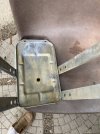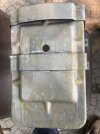I wouldn't argue you if not for the fact that it has happened to me over decades of use, and steels like that are the only ones I have had trouble with.
Just send some clips out to be zinc plated and see how they come back after the shop dips them in acid for cleaning. I must admit though that it might be the length of time they are in the dip. The plating shops use heat to speed it up, and I was using only acid, to clean small parts and that takes time in the acid dip, so a quick dip might be the difference.
I tell the plater that the parts are already clean so skip the acid dip, but sometimes they forget, and some other platers have an assembly line where they require the parts to be wire strung, then they can hang the parts on the moving line and let them go through the whole process automatically.
In fact, my blasted chassis, front beam, and all suspension parts look the same as the tins. I think you're fine.



